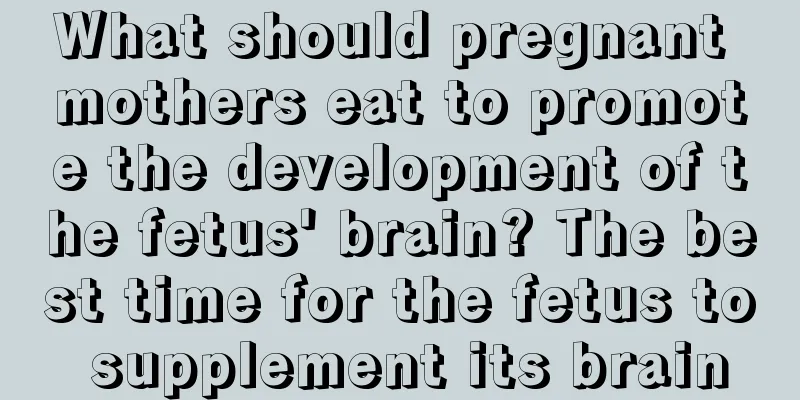How old is considered an advanced maternal age? Is it better for an advanced maternal age mother to have a natural birth or a caesarean section?

|
Many women have to have children in their 30s due to many issues such as late marriage or second child. However, this is already past the best age for conception. Therefore, we must be especially careful in all aspects. So, what concerns should older mothers consider? How old is considered advanced maternal age?Pregnant women over 35 years old are called elderly pregnant women. The risks of their pregnancy can be divided into two aspects: The probability of fetal abnormalities will increase. The function of female ovaries will gradually decline after the age of 35, which will lead to a decrease in egg quality, thereby reducing the chance of pregnancy, increasing the miscarriage rate, and the incidence of fetal malformations; The incidence of complications of pregnant women is significantly increased. Elderly women suffer from hypertension, diabetes, dyslipidemia and other medical diseases more often, which are called pregnancy complications during pregnancy. The probability of elderly pregnant women developing pregnancy-induced hypertension syndrome and gestational diabetes during pregnancy will also increase. For example, gestational diabetes can lead to macrosomia and increase the chance of cesarean section. Therefore, elderly pregnant women are clinically classified as high-risk pregnancies and are the key population for perinatal care. It is recommended to go to the hospital's specialist clinic for examination. Is it better for older mothers to have a natural birth or a caesarean section?Advanced age is not a necessary condition for cesarean section, but considering all factors, the cervix of older mothers is generally tougher, making natural childbirth difficult, so cesarean section is more common among older mothers. In addition, because of the high-risk factors, older mothers have more cesarean sections for safety reasons. In addition, older mothers are most likely to have prolonged labor or dystocia. This is because when a woman reaches middle age, the joints of her ischium, pubic bone, ilium and cuboid bone have basically ossified, forming a fixed pelvic cavity. Therefore, when the fetus is delivered, it is easy to cause labor difficulties, which greatly increases the risk of various complications for the mother herself; it is also very easy to cause the fetus to be retained in the uterus and cause fetal distress. This kind of distress is threatening to the fetus. In mild cases, it can affect the fetus's heart and brain ischemia and hypoxia, and even lead to irreversible brain damage. In severe cases, it can cause fatal suffocation. The main complication of elderly primiparas is pregnancy-induced hypertension, which can easily affect the health and life of the mother and fetus, and should be prevented as early as possible. If there are other diseases, it can lead to premature degeneration of placental function, which is more detrimental to the fetus. These should be taken seriously. In view of the fact that the above-mentioned symptoms may occur in older primiparas, older primiparas and their families must not be complacent but should have a pragmatic attitude and take specific countermeasures according to their own circumstances to prevent problems before they occur. Time for first checkup for older pregnant womenThe first prenatal checkup for older mothers should be done earlier. Normally, the first checkup for pregnant mothers is when they are 12-13 weeks pregnant. If pregnant mothers have the following conditions, they should go to the hospital for a checkup in time, rather than waiting until the 12th week of pregnancy. 1. Pregnant women with adverse birth history: Pregnant women with a history of miscarriage, embryo arrest, or fetal malformation;2. Abnormal conditions occur: such as vaginal bleeding, abdominal pain, severe nausea and vomiting, etc.3. Taking medications during pregnancy or suspecting that you have been exposed to adverse factors that may harm the fetus, such as radioactive substances.4. Older pregnant women or those with a family history of genetic diseases. |
Recommend
What are the hazards of premature delivery?
We all know that there is usually a due date afte...
How can parents help children to complete too much homework?
As soon as children enter kindergarten, they will...
What is the reason for the baby's bad breath? Mothers should pay attention
Many parents have found that their babies occasio...
What should I do if I catch a cold while breastfeeding? Can I still breastfeed if I catch a cold?
Mothers are tired from taking care of their child...
Does skin care products used by breastfeeding mothers have any effect on the baby? Can skin care products be used during breastfeeding?
Everyone loves beauty. Many mothers sacrifice a l...
What should I do if I suffer from insomnia during pregnancy? How to treat insomnia during pregnancy?
Everyone should have heard in life that pregnant ...
There is a bad smell in the baby's ears. What's wrong? Is it caused by ear inflammation?
The ears are important organs that need our good ...
What is the reason for babies to grind their teeth?
What is the problem of baby grinding teeth? Many ...
How to massage your baby to make him grow taller? Easy massage helps him grow taller
During the infant and toddler period, babies need...
How to clean the baby bottle and how to sterilize the baby bottle
Of course, the baby bottle needs to be cleaned af...
Can hawthorn reduce milk production? How much hawthorn should I eat to reduce milk production?
Hawthorn is rich in vitamins and has a very good ...
Reasons for newborns to sleep with milk Harms of babies sleeping with milk
When babies are just born, they like to sleep wit...
How to eat crabs? What is the best way to eat crabs?
The crab season is here. How to cook the big, ten...
How is the quality of Supor thermos cup? What is the material of Supor thermos cup?
Now that the weather is getting colder, I need to...
How long does it take to get menstruation after a caesarean section? What are the symptoms of irregular menstruation after a caesarean section?
As we all know, the various care and physical con...









